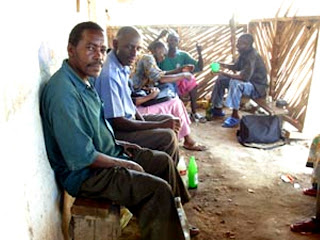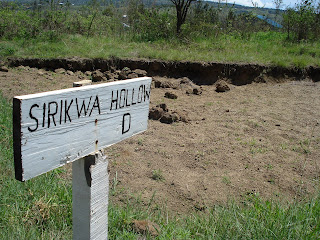By Eric Sindabi and Harrisson MuigaiIt is a hot afternoon as we arrive at Kihingo village along Nakuru/Mau Narok highway. An elderly woman is seated on a wooden chair outside her home a few meters away from the business centre. She toys with the hair of one of her grandchildren and she seems to readily welcome visitors in her home regardless of their mission. However her composed body posture and nostalgic appearance is makes it difficult for one to judge her but she has a sad story to tell anyway.
"I am Hannah Wanjiru Ndun'gu," She introduces herself then pauses obviously calling upon us to introduce ourselves further.
After serving us a cup of tea, Wanjiru gathers incredible courage to start narrating an inflicting emotional story of how her son Samwel Ng'ang'a, drunk a lethal brew and diedsometime back.She now takes care of his widow and children. Samwel Ng'an'ga then a 36year old father of two and a habitual drunkard had been on a drinking spree with a friend the night before he died. He had ventured into his mother's compound where he lived with his wife crawling and unable to neither walk nor talk. . When he had managed to mutter few words all he had said was that he had consumed the killer brew, then collapsed and died.
Killer brew
Funuki, as the killer brew was popularly known in Kihingo Location of Njoro Division is a corrupted Swahili word for bunduki (Gun).The illicit brew was responsible for deaths of more than twenty people in the area in a span of only six months some five years ago.The highly addictive and mysterious brew caused deaths more indirectly than directly under bizarre circumstances. Those who consumed the deadly brew some times died instantly, committed suicide, murdered others or destroyed property while others ran amok.
"It was a queer brew that brought untold tragedy in this area" says Edward Mwangi a village elder. Mwangi who has been a local opinion elder for a long time says that illicit brews have been consumed in the village since 1974. He says, people who are involved in illicit brews business have ever been apprehended and charged in law courts but could crop up after a while to keep the illicit business alive.
According to the opinion leader, many young people easily get hooked to illicit drinks because of poverty and idleness. In turn the lives and social economic standards of the youths get shattered. Many turn to be hopeless in life while others lose their lives
Mzee mwangi however says that the common Busaa and Chang'aa illicit brews that were originally the common illegal brews in the area were not as lethal as funuki proved to be. “Drinking was rife but the brews did not cause tragedy as was the case with funuk”.He recalls.
Crime
"Crime in the area escalated. Young men spend most of their time roaming around shopping centers and drinking spots. Where do you think they got money to drink funuki?" Mwangi wonders aloud. He says, Villagers complained after losing property to petty thieves while rampant mugging incidences were reported. An accusing hand was directed at the young men who were hooked to funuki .He says through investigations some culprits were arrested and charged in court but that did not however improve the situation. The community was definitely suffering the consequences of the deadly brew.
Notorious
Funuki was in existence since early 2001 after a group of local notorious illicit brews dealers introduced it. The killer brew was allegedly manufactured by dissolving an unknown powder in water. The solution become alcoholic instantly. Though tasteless, colorless and unscented the wonder brew’s effects were strange.
Funuki was sold secretly in the homesteads of selected dealers. Revelers entered the venues that were secured with iron gates, and made an order. A seller could then fetch water from a tap and dissolve an un known powder in cups of water to prepare a drink for consumption by a reveler.
The seller knew his customers well and could only serve a new reveler if accompanied by a regular one. After taking their respective shares, revelers could be seen past the gates by the seller immediately they finished drinking “This ensured that the alcohol effects on revelers did not occur while they were in the compound.
The liquor, which cost Ksh.30, a cup was anonymous in origin and only the dealers held the secret of its ingredients. This according to villagers was to keep at bay potential competitors into the illicit business.
Far reaching
The effects of funuki were incredible and far reaching. A person under the influence of it could suffer from acute diarrhea and vomiting or he become very violent.
Many cases of violence were common with revelers. According to villagers, in one of the incidences, a middle aged man had lured his girlfriend to drinking spree of funuki and afterwards killed her in cold blood. In yet another incidence two brothers fought at their father's home resulting to the death of one of them. They had been drinking funuki together.
"My son Douglas Muiruri aged 34 was found dead in September 2001 in a disused quarry," says Anne Waithaka a retired teacher. Muiruri who left behind a widow and one child had been drinking funuki when he met his death.
A local business man Ndung’u Karanja has also had a share of the agony. His son Josephat Kagombe who was aged 28, under the influence of funuki committed suicide. Kagombe had taken to drinking and quarreled with his wife on daily basis. He could extend his fury to members of his extended family even after his father having warned him several times not to venture into his house while drunk.One day, Kagombe had entered his father's house in a drunken state before picking up a quarrel with his parents. Then he had dashed out of the house. His father thinking that he had gone for a weapon to use to attack him, had too looked for a crude weapon and stood alert, waiting for the would be assailant. However that was not the case. Kagombe had gone for a poison but not a weapon. He had died soon after consuming rat rat.
Orphans and School dropouts
Tens of old people in Kihingo are taking care of their grandchildren and their mothers after their sons allegedly died after consuming the deadly funuki . May be this is the worst effect the mysterious drink ever had on this Njoro community. David Wamathingira, a teacher at the local Larmudiac Primary School and the Kenya National Union of Teachers Nakuru district deputy treasurer says that funuki likewise affected the area seriously on the education side.
"Most parents who consumed the brew neglected their families which meant they could not provide fees and other basic needs to their school going children.He says that as a result many children dropped out of school. On the other hand some teachers were interdicted for desertion of their duties. “These teachers were addicts of funuki. Says Mr. Wamathingira.
War against the killer brew
In fighting the sale and drinking of the brew, the church, the government and residents put up a spirited war against the killer brew. The local church leaders decried the brew business during funerals of victims and in church sermons.The men of cloth made humble appeals to residents especially the youth to dissist from the temptations of the deadly brew. The campaign by the church was followed by demonstrations by residents urging the government to arrest and prosecute funuki dealers.This seemed to have worked as the local provincial administration officials soon organized a man hunt to arrest the illegal lethal brew dealers. However villagers say that it was not easy as such. The dealers proved very slippery and went underground. The villagers say that a continued manhunt for the brewers by police however frustrated their business and that is what contributed to the diminishing of the killer brew. Meanwhile church leaders were intensifying their efforts to win more people to church. Many crusades were organized where preachers discouraged locals’ against the brew. All these efforts saw to the end of the reign of the killer brew. Nevertheless memories of the tragedies that funuki caused to this community will never cease.
Sociologists have warned that alcohol consumption in Kenya is a major social economic problem. According to NACADA the national agency against drug abuse, at least 70% of Kenyans consume alcohol.

.jpg)
































